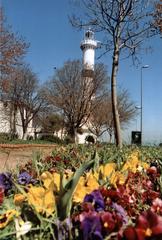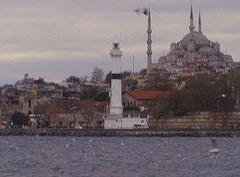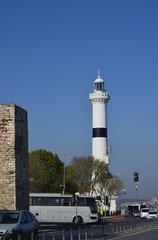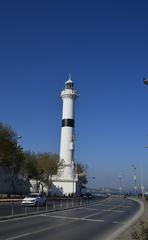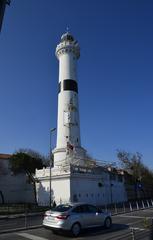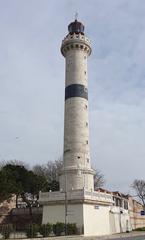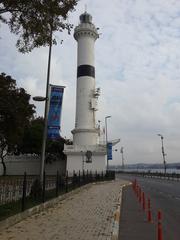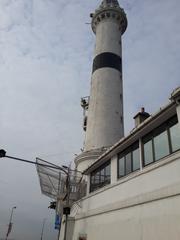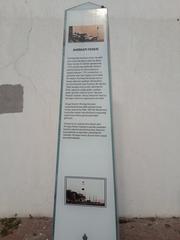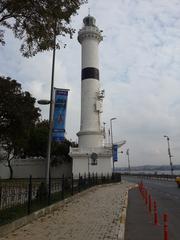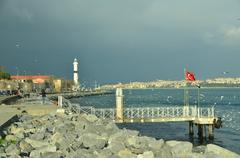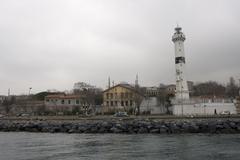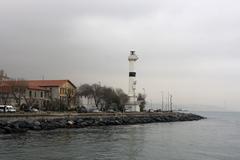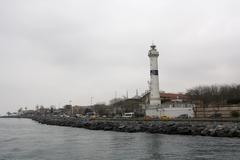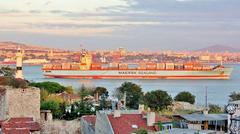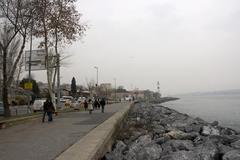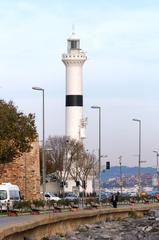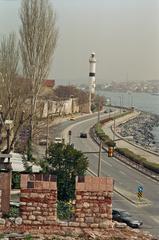
Visiting Ahırkapı Feneri: History, Tips, and Visitor Information
Date: 25/07/2024
Introduction
Ahırkapı Feneri, commonly known as the Ahırkapı Lighthouse, is a historic maritime beacon situated at the southern entrance of the Bosphorus Strait in Istanbul, Türkiye. Commissioned by Sultan Abdülmecid I in 1857, this lighthouse has served as a critical guide for ships navigating the busy waters between the Sea of Marmara and the Black Sea (Trek Zone). The cylindrical stone tower, painted in white, stands at 26 meters tall and boasts a light visible from 16 nautical miles, flashing every 5 seconds (Wikipedia). Over the years, Ahırkapı Feneri has evolved from an oil lamp to a modern LED light, reflecting the technological advancements in maritime safety (Pera Museum). This iconic structure not only symbolizes Istanbul’s rich maritime history but also continues to play a vital role in ensuring safe navigation through one of the world’s busiest straits. Whether you’re a history enthusiast, a maritime buff, or a curious traveler, Ahırkapı Feneri offers a fascinating glimpse into Istanbul’s heritage. This comprehensive guide covers everything you need to know, from its historical significance and architectural beauty to practical visitor tips and nearby attractions.
Table of Contents
- Introduction
- History of Ahırkapı Feneri
- Preservation and Maintenance
- Modern-Day Relevance
- Visitor Experience
- Accessibility and Visitor Tips
- Visiting Hours and Tickets
- Nearby Attractions and Special Events
- Conclusion
- FAQs
History of Ahırkapı Feneri
Origins and Construction
Located at the southern Seraglio Point on the Rumelian coast of the Bosphorus’ south entrance, the Ahırkapı Lighthouse was commissioned by Sultan Abdülmecid I and constructed in 1857. The primary purpose was to aid in the navigation of ships entering the Bosphorus Strait from the Sea of Marmara, a critical juncture for maritime traffic (Trek Zone).
Architectural Design
Standing as a testament to 19th-century Ottoman architecture, the lighthouse is a cylindrical stone tower painted white for high visibility. It is 26 meters (85 feet) tall, and its light is visible from a distance of 16 nautical miles. The lighthouse’s light characteristic is a white flash every 5 seconds, which has remained unchanged since its inception (Wikipedia).
Technological Advancements
Initially using an oil lamp, the lighthouse has undergone several upgrades, including a kerosene lamp in the early 20th century and electrification by mid-century. Today, it employs modern LED technology, making it both energy-efficient and environmentally friendly (Pera Museum).
Historical Significance
The lighthouse played a crucial role during the Ottoman era, aiding numerous ships navigating one of the world’s busiest maritime routes. It symbolized the Ottoman Empire’s commitment to maritime safety and technological advancement, particularly in their efforts to modernize maritime infrastructure (Pera Museum).
Cultural Impact
Featured in numerous works of art, literature, and photography, the lighthouse is also a cultural icon. A notable example is Michael Zeno Diemer’s painting from 1906-1907, part of the Pera Museum’s collection, which highlights the lighthouse’s significance as a cultural and historical landmark (Pera Museum).
Preservation and Maintenance
Maintaining the Ahırkapı Lighthouse has been a priority for Turkish maritime authorities. Restoration projects have included repairing stone masonry, repainting the tower, and upgrading the lighting system. The lighthouse is managed by the Directorate General of Coastal Safety (Wikipedia).
Modern-Day Relevance
Despite modern navigation technologies like GPS, the Ahırkapı Lighthouse remains an essential component of maritime safety, guiding ships safely through the narrow Bosphorus Strait.
Visitor Experience
While the lighthouse itself is not open to the public, it offers a picturesque setting with stunning views of the Bosphorus and the Sea of Marmara. Visitors can explore nearby historical landmarks such as the Hagia Sophia, Topkapı Palace, and the Blue Mosque, making it a popular spot for photography, especially during sunset (Mapcarta).
Accessibility and Visitor Tips
Easily accessible from the Sultanahmet-Old City area, visitors can take a tram to the Sultanahmet stop and walk to the lighthouse. For a comfortable visit, it’s advisable to go during early morning or late afternoon to avoid the midday heat, especially in summer. Comfortable walking shoes and a camera are essential for capturing the stunning views.
Visiting Hours and Tickets
While specific visiting hours and ticket prices are not available due to the lighthouse’s operational status, it’s recommended to check with local tourism offices or online resources for the most current information.
Nearby Attractions and Special Events
The lighthouse’s vicinity includes several historical landmarks. Special events and guided tours may be available, providing a comprehensive experience of Istanbul’s rich maritime heritage.
Conclusion
Ahırkapı Feneri stands as a testament to Istanbul’s rich maritime heritage and the Ottoman Empire’s commitment to modernizing its nautical infrastructure. Despite the advent of advanced navigation technologies, this historic lighthouse continues to serve as a vital aid for ships navigating the narrow and treacherous Bosphorus Strait. Its architectural elegance, historical importance, and picturesque setting make it a must-visit landmark for anyone exploring Istanbul’s maritime past. Visitors can not only enjoy stunning views of the Bosphorus and the Sea of Marmara but also delve into the nearby historical landmarks like the Hagia Sophia, Topkapı Palace, and the Blue Mosque, enriching their experience (Mapcarta, Istanbeautiful, The Wandering Quinn). Whether you’re taking a guided tour or simply exploring on your own, Ahırkapı Feneri offers a unique blend of history, culture, and natural beauty that is sure to leave a lasting impression.
FAQs
- What are the Ahırkapı Lighthouse visiting hours? While the lighthouse is not open to the public, the surrounding area can be visited at any time.
- Are there guided tours available? Check with local tourism offices for any available guided tours.
- What are the best times to visit? Early mornings or late afternoons are ideal to avoid the midday heat.
- Is there an entrance fee? There is no entrance fee to view the lighthouse from the outside.
- What nearby attractions should I visit? The Hagia Sophia, Topkapı Palace, and the Blue Mosque are all in close proximity.
For more information and updates, follow our social media channels or download our mobile app.
References
- Trek Zone. Vernacular Architecture of Istanbul. Retrieved from Trek Zone
- Wikipedia. List of Lighthouses in Turkey. Retrieved from Wikipedia
- Pera Museum. The Ahırkapı Lighthouse by Michael Zeno Diemer. Retrieved from Pera Museum
- Mapcarta. Ahırkapı Feneri. Retrieved from Mapcarta
- Istanbeautiful. Top 10 Best Things to Do in Istanbul in July. Retrieved from Istanbeautiful
- The Wandering Quinn. Things to Do in Istanbul. Retrieved from The Wandering Quinn
